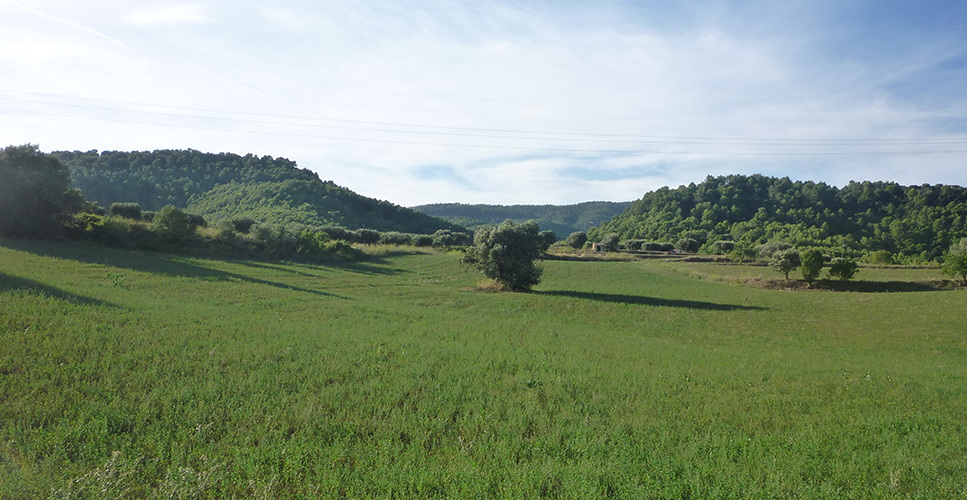
Route between Sentmenat Caldes de Montbui, in the northeast area of the region. It is a circular road of approximately an hour and a half, which shows the unique landscape of the plain of the Vallès, combination of dry farming and Mediterranean forest of the area. We can do routes of longer duration, of an entire morning or afternoon, throughout the day, and even of a weekend, always by well-preserved natural landscapes of medium mountain, near the Parc Natural de Sant Llorenç del Munt i l’Obac. Also, there are offered excursions to the plain of the Vallès, especially recommended in winter.
ROUTE
This route is a good sample of the rural landscape which, throughout history, has formed the region, before the expansion of residential areas and industrial estates. Falling between the municipalities of Sentmenat and Caldes de Montbui, we will pass by different masias and subtle varieties of Mediterranean forest.
We will leave the riding centre by the access road to the left and will pass in the middle of dry farming: olive trees to the right and left, here alternated with hazelnut trees, with large and vigorous leaves. On the right we can see the old Mas d’en Cisa. When we turn to the path to the right, we visualize the summit of the mount de la Creu at the back, with grain crops in the first place.
When the path goes down slightly to the left, we pass by the side of a careful fence with olive trees, lavender and sunflowers on the right. A series of canes and almond trees follow the profile of the wheat field to be raising as we go down until we pass a small torrent. The margins of the path, increasingly high and clayey, are a good example of the rich agricultural land in the area. We find full of ruderal species: white rocket, gorse, fennel, different grasses… that attract a wide variety of snails, spiders, butterflies and other insects.
After the torrent, we move forward a few meters surrounding the industrial state Mas d’en Cisa to the right, up to recover the path between the fields of grain. When we arrive to a large fig tree we can see Can Fruitós in front and the castle of Sentmenat to the left.
Currently it is being restored as a museum and restaurant. When we arrive to the castle, we find the main track towards Can Fruitós: we turn to the right, passing next to large oaks and after a few holm oaks and pine trees. We can follow this main track that runs between fields and pine forest or take a detour to the left that will take us for a walk by the vegetable gardens, which are always interesting as an example of cultivation of traditional irrigation, in contrast with the dry fields that we see the rest of the way. Along this path we will have a fantastic view of the back of the castle, on the ravine where we will find a few good specimens of pine trees, with the tighter cup and a more intense green that that of the white pine. We find a path that leaves towards Castellar and the residential area of Can Vinyals.
When we leave behind the vegetable gardens, we find alternation between dry farming and young forest of holm oak, with some feral vineyards, until we recover the main path, which we will take to the left again. In this stretch we can enjoy the more traditional aromatic plants: rosemary, lavender and thyme, which we will smell when horses graze them.
We continue along the main road, where to right and left we can see large white pine trees with young holm oaks growing up with force in their shade and with white steppe in the sunny clearings. When we find a fire hydrant, on the left there is a shortcut to Guanta, for those with a bit of experience since it is a closed path.
We continue along the path until we find the Guanta and right away we find a stone bench in the area; behind it starts a path towards the spring of the Bou, only for experts. In this bank there usually lay the people of Sentmenat when walking up to the Virgin surrounded by flowers that we will find just turning the curve.
At this point the path has a greater slope, the terrain is more clayey and we continue climbing between forest consisting of white pine and holm oaks. All of a sudden we will have a stunning view of the castle of Guanta, camouflaged by the vegetation on the rock, and the masia of Can Senosa at the foot. In a curve in the path, we find the access to the masia.
Our path continues rising. We can see how the undergrowth is becoming more dense, of heather and mastic trees, until we arrive to a small esplanade where on the right we will find a path that goes up to the end of the hill, where we will find beautiful surprises: two archaeological remains of the 4th century BC, remains of an Iberian village that is still being studied and the Torre Roja, remains of a small fortress built during the 14th century. The last surprise is the spectacular view of the entire Vallès plain and the Serralada Litoral which obviously made the fortress a good place of surveillance.
We return by the path and continue to the wide road on the right. We begin the descent, soft and winding, following the profile of the mountain. In this sector, more exposed to the sun, we see how it dominates the white pine and the undergrowth is poorer.
We can see how the field is becoming more calcareous before opening to the dry fields of olive trees and forage. We arrive to a crossroads: to the left we would go towards the Roure Gros and Caldes, straight ahead towards the Torre Marimon and to the right we head back to the riding centre.
Now we are back at the top of the Vallès plain, where we can see the richness of the different crops: the ruderal species that surround them, beginning with a few large American aloes on the right, the stubbles of mid-summer, the brambles in flower of the spring and the blackberries in the Autumn, all of them decorated with flowers of different colours such as white and yellow rockets and red poppies.
ACCUMULATE GRADE

DON’T MISS…

Mas d’en Cisa: masia that was part of the territory of the County. Established as mas Vilar at the end of the 12th century, it appears as mas d’en Cisa in the 15th century. The structure is made of stone partition walls and forgings are constituted by beams and wooden tables. In the living room of the ground floor there is a doorway with a semi-circular arch and a built-in sink of stone warehouse, with three embossed faces (17th-19th centuries), which is located in the wall of the main facade.
Can Senosa: masia also known as Mas d’Aiguasenosa, located in the valley of the same name and on the territory of the former County. It is documented for the first time in 1002. A number of remodellings and changes have blurred its original form; despite this, you can still observe a gothic window of the primitive construction.
The Castle of Guanta: above the House of Guanta, on the hill of the Corb or del Moro, it stands the castle of Guanta or of the Moors, of which there are only a few debris. It also receives the name of the castle of the Moro.
By documentary chronology, it is previous to the castle of Sentmenat, since it is mentioned for the first time in 1012. It seems that the origin of the place name Guanta is in the name of the person Gonter, of the 10th century. The Castle of Guanta was part of the network of defence castles and Christian watchtowers against the incursions of the Muslim troops located beyond the Llobregat. It was, according to the legend, refuge of the count Borrell.
House of Guanta: the house of Guanta is from before the 15th century but the documentation of the existence of this masia is unclear, although there are reports of Guanta and Castellet de Guanta lineages since the 13th century. The distinction between little castle and house cannot be done until the 15th century.
The Castle of Sentmenat: originally, it was a defensive building of irregular plant, which has been transformed into an agricultural building over time. The building develops, in the shape of a horseshoe, around a central courtyard. Currently, the ground floor is used as a warehouse, the first floor as a residence and the second floor as an annex.
The first time that its name appears is in 1056 and it is linked to Ramon Miró. In 1380, Pere de Sentmenat obtained the lordship of the castle and its area. The building is entirely made of stone, fairly well preserved in its exterior, open on the West side and fenced on the East side by a thick wall, which in some points achieves a thickness of 3.40 m. This wall provided protection to the flat part, more accessible and easy to be attacked.
Inside you can see several Gothic arches, some of them covered by walls, and a magnificent barrel vault, which now covers the entire length of the corridor parallel to the East wall. Above the main door it can be seen a shield with three wings: this is the emblem of the Sentmenat. The castle has at his side a very remodelled chapel dedicated to Sant Jaume, where they are buried almost all of the marquis of Sentmenat of these last two centuries.
Iberian village: on the plain which constitutes the hill of the Torre Roja it is demonstrated the evidence of the existence of the remains of an important Iberian village. Currently the services of Archaeology of the Generalitat carried out some excavations with positive results.
The Torre Roja: remains of a defence tower of circular plan, the wall of which was subsequently circumscribed by another wall, possibly during the same period. The tower, with walls of 190 cm thick, is built with stone partition walls arranged in horizontal rows and forming, in good part, “opus spicatum” fish bone.
The external facing, with a thickness of 155 cm, is attached to the tower and has no internal face. The wall that form facing is made with large ashlars, possibly taken of previous constructions (on the same side there is an Iberian village), despite that, it could also be part of a previous building.
The original name was Castellar or Puig Castellar, (14th century). Despite the fact that during the 11th and 12th centuries there existed the lineages Penya Roja and Turre Rubea in Caldes, the name “Torre Roja” does not appear, and indirectly, until 1529. The interior tower is from the 10th century.
SUGGESTIONS
The forest and the torrent of Guanta, mount of la Creu, the dolmen of Serra Cavallera and Can Fruitós are points of interest near this route.
Also you may be interested in…
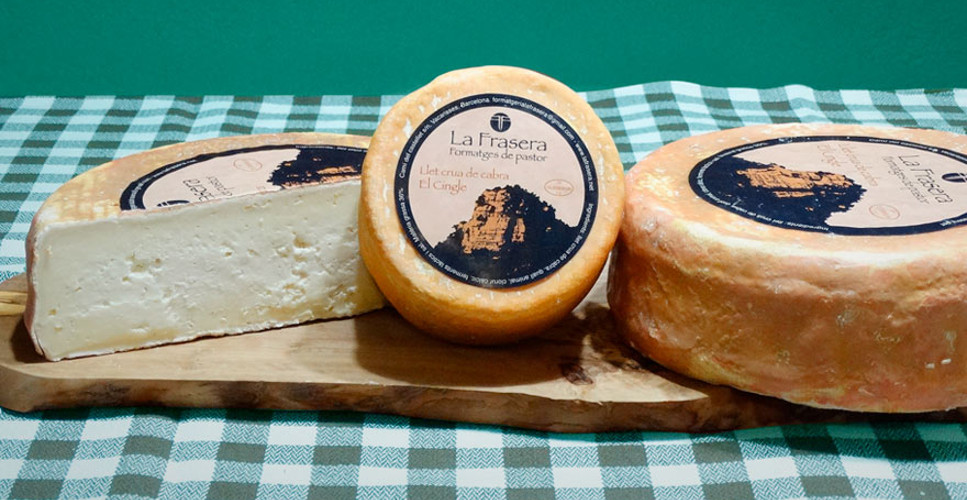
Local products
In the Vallès, you will find a number of unique products linked to the territory. Come and try them all!
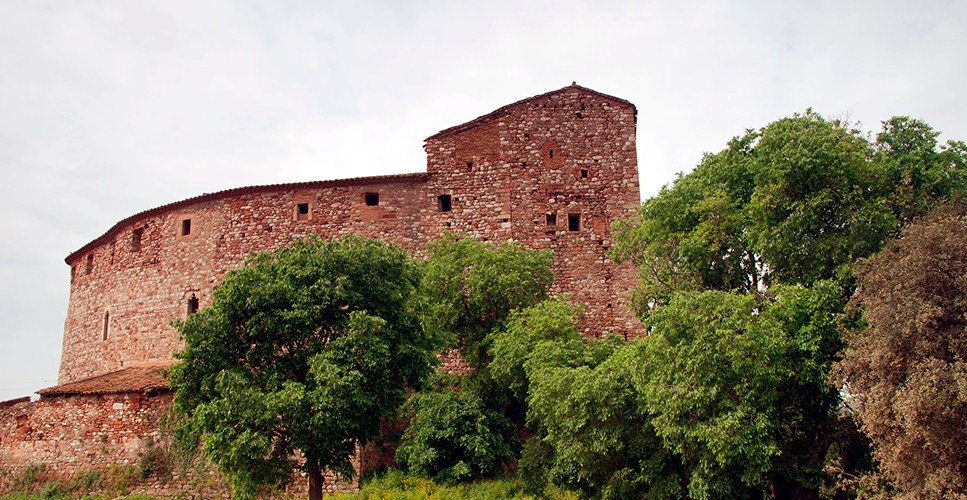
Surroundings of Sentmenat
Cycling route around Sentmenat, ideal to know the history of the town.
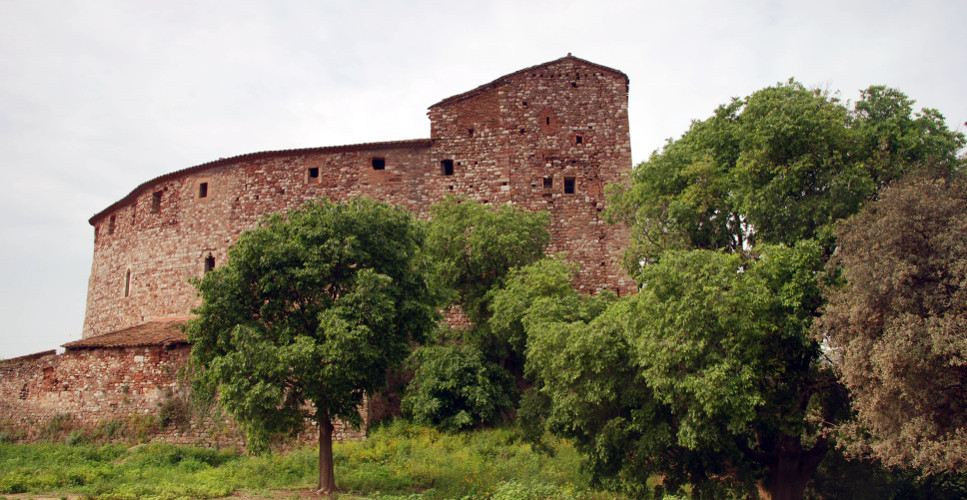
Castle of Sentmenat
Building dating back to 1056 and which has its origins as castle of the area.




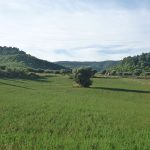
No Comments